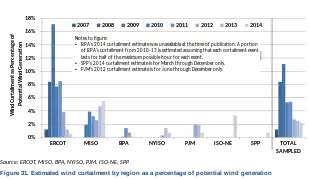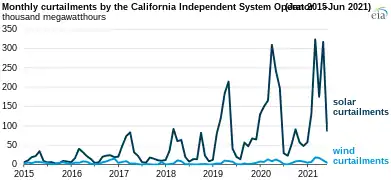Curtailment (electricity)
In electric grid power generators, curtailment is the deliberate reduction in output below what could have been produced in order to balance energy supply and demand or due to transmission constraints.[1][2][3] The definition is not strict, and several types of curtailment exist. "Economic dispatch" (low market price) is the most common.[4]
Curtailment is a loss of potentially useful energy, and may impact power purchase agreements.[5][6] However, utilizing all available energy may require costly methods such as building new power lines or storage, becoming more expensive than letting surplus power go unused.[7][8][9][10]
Examples
After ERCOT built a new transmission line from the Competitive Renewable Energy Zone in West Texas to the central cities in the Texas Interconnection in 2013, curtailment was reduced from 8-16% to near zero.[11]
Curtailment of wind power in western China was around 20% in 2018.[12]
In 2018, curtailment in the California grid was 460 GWh, or 0.2% of generation.[13] Curtailment has since increased[7][14] to 150-300 GWh/month in spring of 2020 and 2021,[15][16] mainly solar power at noon as part of the duck curve.[17]
In Hawaii, curtailment reached 20% on the island of Maui in Hawaii in the second and third quarters of 2020.[18]
 Curtailment in Texas
Curtailment in Texas Monthly curtailment in California
Monthly curtailment in California Solar power and curtailment in California, by hour
Solar power and curtailment in California, by hour
Mitigation options
- Transmission upgrade[11]
- Demand response[7][19][17][20]
- Battery storage power station
- Energy forecasting, including forecasting for price, wind and solar
References
- Freehill-Maye, Lynn (8 October 2020). "California has a renewables curtailment problem. Can your Google and Facebook activity help?". Utility Dive. Archived from the original on 12 October 2020.
- Lori Bird, Jaquelin Cochran, and Xi Wang (March 2014). "Wind and Solar Energy Curtailment: Experience and Practices in the United States" (PDF). NREL. Archived (PDF) from the original on 1 September 2020.
Curtailment is a reduction in the output of a generator from what it could otherwise produce given available resources, typically on an involuntary basis
{{cite web}}: CS1 maint: multiple names: authors list (link) - Lori Bird, Jaquelin Cochran, and Xi Wang (17 October 2014). "Wind and Solar Energy Curtailment Practices (brief)" (PDF). NREL. Archived (PDF) from the original on 9 June 2017.
{{cite web}}: CS1 maint: multiple names: authors list (link) - Paulos, Bentham (3 April 2017). "Too Much of a Good Thing? An Illustrated Guide to Solar Curtailment on California's Grid". www.greentechmedia.com. Archived from the original on 26 September 2020.
CAISO considers three types of curtailment: Economic dispatch, a self-scheduled cut, and exceptional dispatch. These can all happen at the local level, to reduce congestion, or at the system-wide level, to reduce oversupply.
- "How to Manage Curtailment in a Virtual Power Purchase Agreement". LevelTen Energy. 13 February 2019. Archived from the original on 7 August 2020.
- St. John, Jeff (26 November 2019). "Do Preventative Blackouts Put California's Renewable Generators at Risk?". www.greentechmedia.com. Archived from the original on 10 August 2020.
PG&E will effectively shut down projects during public safety power shutoff (PSPS) events, and then not pay the developer for the lost production
- Specht, Mark (25 June 2019). "Renewable Energy Curtailment 101: The Problem That's Actually Not a Problem At All". Union of Concerned Scientists. Archived from the original on 1 September 2020.
In most cases, it simply does not make economic sense to build all the infrastructure (e.g. transmission lines or energy storage) that would be required to utilize every last drop of renewable electricity
- Elliott, Dave (10 July 2019). "Curtailment: losing green power". Physics World. Archived from the original on 7 August 2020.
- "Archived copy" (PDF). Archived from the original (PDF) on 2018-08-22. Retrieved 2020-10-22.
{{cite web}}: CS1 maint: archived copy as title (link) - "Curtailment of low-cost renewables a cost-effective alternative to 'seasonal' energy storage". Clean Power Research. 13 February 2019. Archived from the original on 13 August 2020.
- Wiser, Ryan H., and Mark Bolinger. "2014 Wind Technologies Market Report" page 38. Lawrence Berkeley National Laboratory, August 2015.
- Fairley, Peter (21 February 2019). "China's Ambitious Plan to Build the World's Biggest Supergrid". IEEE Spectrum. Archived from the original on 20 August 2021.
- Victor, David G. (21 May 2019). "Pumped Energy Storage: Vital to California's Renewable Energy Future" (PDF). pp. 4, 12–15.
- "California ISO - Managing Oversupply". www.caiso.com. Archived from the original on 14 October 2020.
- Hornyak, Tim (1 November 2020). "An $11 trillion global hydrogen energy boom is coming. Here's what could trigger it". CNBC. Archived from the original on 20 May 2021.
- Aniti, Lori (24 August 2021). "California's curtailments of solar electricity generation continue to increase - Today in Energy - U.S. Energy Information Administration (EIA)". www.eia.gov. Archived from the original on 25 August 2021.
- Pyper, Julia (9 May 2019). "Electric Ridesharing Benefits the Grid, and EVgo Has the Data to Prove It". www.greentechmedia.com. Archived from the original on 18 October 2020.
the cumulative annual load profile by hour of LDV fleets using its fast charging network — with rideshare vehicles currently making up the lion's share on a gigawatt-hour basis — aligns with the cumulative solar curtailment by hour on the CAISO system
- "Renewable Energy". www.hawaiianelectric.com. Archived from the original on 15 September 2021.
- Chelmis, Charalampos; Saeed, Muhammad Rizwan; Frincu, Marc; Prasanna, Viktor (14 July 2015). "Curtailment Estimation Methods for Demand Response: Lessons Learned by Comparing Apples to Oranges" (PDF). Proceedings of the 2015 ACM Sixth International Conference on Future Energy Systems. pp. 217–218. doi:10.1145/2768510.2775332. ISBN 9781450336093. S2CID 16488954. Retrieved 9 November 2022.
- Zheng, Jiajia; Chien, Andrew A.; Suh, Sangwon (October 2020). "Mitigating Curtailment and Carbon Emissions through Load Migration between Data Centers". Joule. 4 (10): 2208–2222. doi:10.1016/j.joule.2020.08.001. S2CID 225188834.
load migration within the existing data center capacity during the curtailment hours in CAISO has the potential to reduce 113–239 KtCO 2e per year of GHG emissions and absorb up to 62% of the total curtailment with negative abatement costs in 2019
External links
- Increase in curtailment in California, 2014—2022
- Curtailment curves in South Australia, peaking at 69% (Christmas 2021)